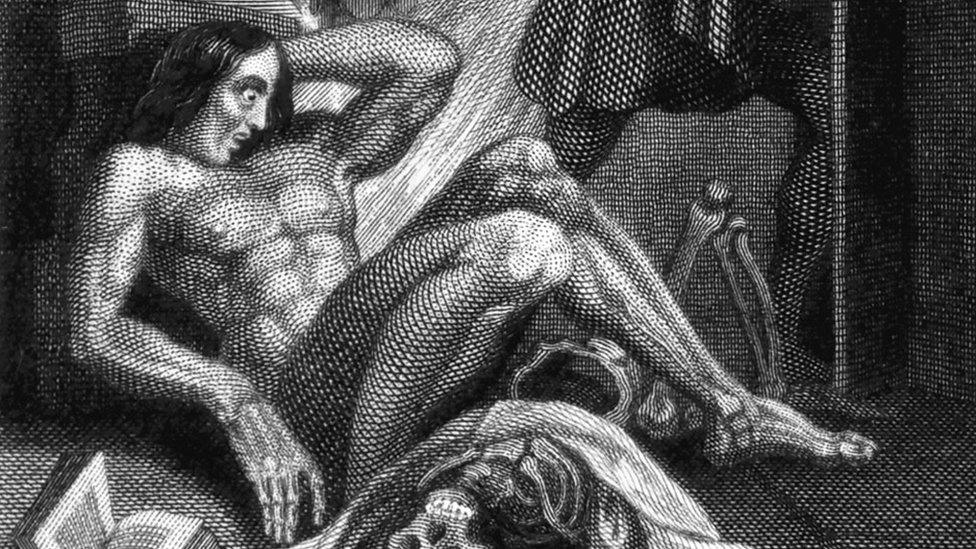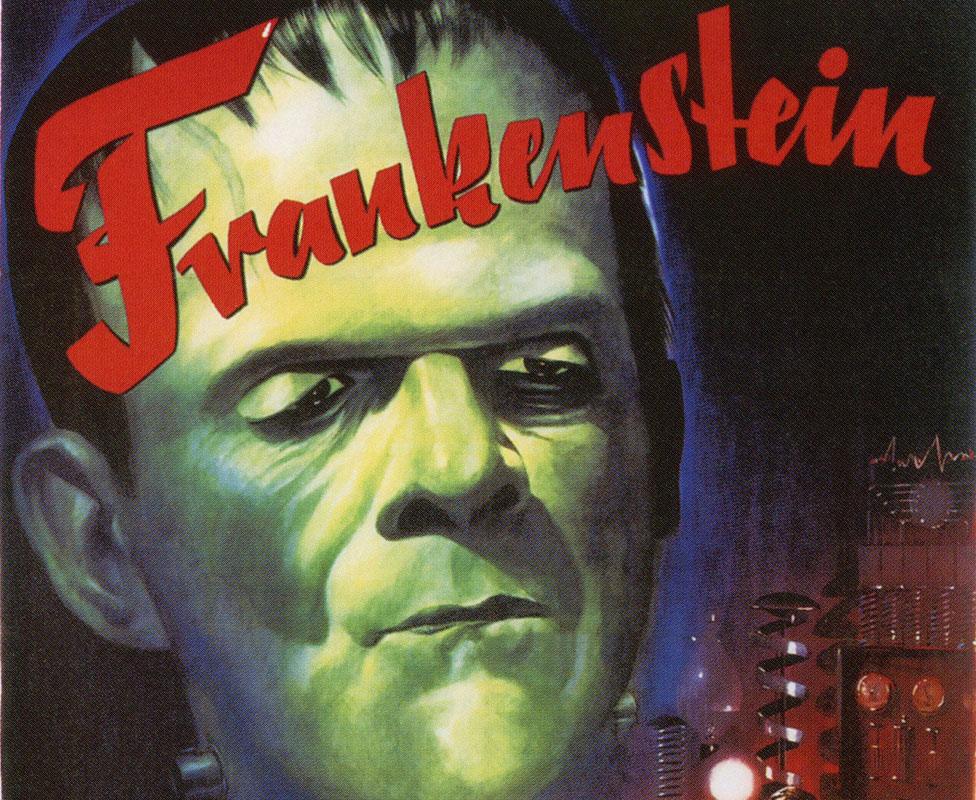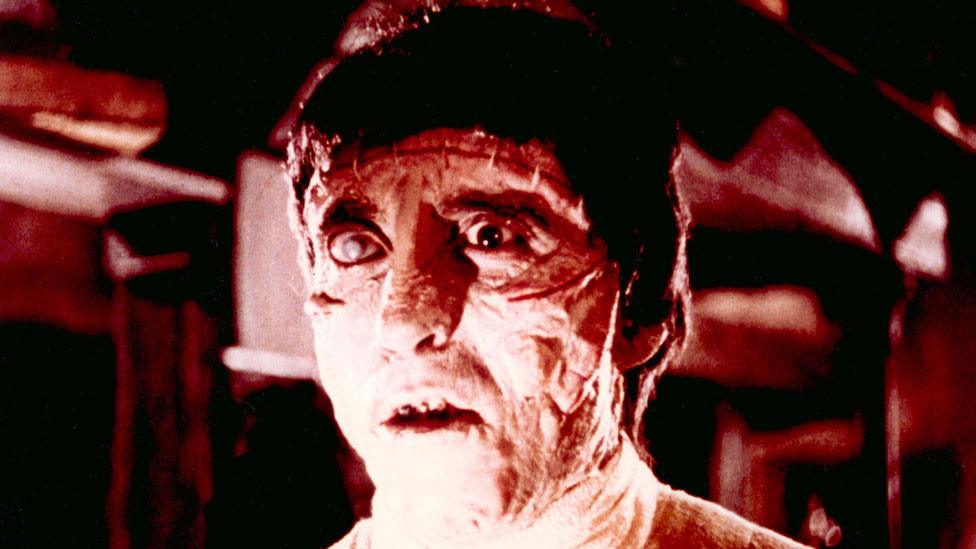Frankenstein: Behind the monster smash
- Published

This year marks the 200th anniversary of the publication of Mary Shelley's classic novel Frankenstein - first printed on 1 January 1818.
Shelley came up with the idea at the age of 18 after being challenged by romantic poet Lord Byron, while in Switzerland, to construct a ghost story. The results were to have a monumental impact. This was the kernel from which the story of Frankenstein would emerge.
The novel - originally published without Shelley's name - received mixed reviews, but came into prominence after being picked up and re-versioned by theatre companies a few years later. However, it was cinema that really took the ball and ran with it.
The first adaptation for the silver screen was made in 1910. Since then, there have been about 150 further versions on different mediums. But why is the story still such a success and how close are modern adaptations to Shelley's original novel?

'The quintessential teenage book'
Horror films have imprinted the idea of Frankenstein as a story about a murderous, unthinking, man-made monster. But Shelley's original creation was quite different.
"Shelley's dealing with the same themes the Greeks were dealing with," says Patricia MacCormack, professor of continental philosophy at Anglia Ruskin University, who has published papers on the horror genre.
"The good film versions share a critical view of life, looking at what our purpose is and the role we fill. The monster did not choose to be born and questions its own existence: 'How do I become a good person?'"
Shelley's creature, brought to life by Victor Frankenstein, was characterised as sensitive, nuanced and inquisitive. Professor MacCormack says the creature addresses the most fundamental human questions: "It's the idea of asking your maker what your purpose is. Why are we here, what can we do?"
Film director Guillermo del Toro describes Frankenstein as "the quintessential teenage book" and says he hopes to one day make a modern re-telling of the story.
"You don't belong," he told Den of Geek, external. "You were brought to this world by people that don't care for you and you are thrown into a world of pain and suffering, and tears and hunger. It's an amazing book written by a teenage girl. It's mind blowing."

Frankenstein illustration from 1831
Shelley's novel also contains the fantastical and the horrific - and it's the combination of these elements which have made the story such a success.
"We're fascinated because it talks about that relationship between life and death," says Dr Sorcha Ni Fhlainn, senior lecturer in film studies at Manchester Metropolitan University and member of the Manchester Centre for Gothic Studies.
"Death is an absolute. So the idea that you can reanimate flesh is both shocking and enthralling."

Frankenstein, 1910
A 16-minute short film produced for the Thomas Edison Film Company made in the very early days of cinema used Frankenstein as its subject. Released in 1910, almost 20 years before the advent of sound in film, it shows Victor Frankenstein in a domestic narrative, preparing to get married.
"It's one of the first films and shows a collection of quite bizarre makeup, mop of hair and mess of sinew," says Dr Ni Fhlainn, who nevertheless describes it as "absolutely brilliant".

Frankenstein, 1931
With the cries of, "It's alive, it's alive!" the 1931 Universal Studios film gave us the most enduring image of Frankenstein's monster, played by Boris Karloff.
"That's the iconic one. Karloff's depiction cemented it in popular culture," says Dr Ni Fhlainn.
"The bolts show up his artificiality and otherness. And we see the same imagery time and again in, for example, The Munsters, The Addams Family and then in cartoons like Scooby-Doo."

The 'definitive' Frankenstein movie image
"It created the definitive movie image of the mad scientist and his monster," says Sir Christopher Frayling, author of Frankenstein: The First Two Hundred Years.
"And in the process, [it] launched a thousand imitations: all subsequent film versions of Mary Shelley's novel have had to take into account how their plot, characterisations and make-up conform to, or differ from, the Universal Studios template."
Allow YouTube content?
This article contains content provided by Google YouTube. We ask for your permission before anything is loaded, as they may be using cookies and other technologies. You may want to read Google’s cookie policy, external and privacy policy, external before accepting. To view this content choose ‘accept and continue’.
This is also where the hulking, groaning version of Frankenstein's monster comes from says Professor MacCormack.
"There is a brutism but also a vulnerability - there are very few versions which show him differently. The monster responds in a way a child or an animal does when they are threatened or afraid.
"It's ironic that in these depictions the monster is seen as less than human but has super-human strength," Professor MacCormack adds.
However, it is the 1935 follow-up which is the real hit for many.

The Frankenstein to 'launch a thousand imitations'
"The Bride of Frankenstein is closer to the novel," says Professor MacCormack. "It introduces the themes of pathos and self-loathing, bringing the monster into this set of relations. It also shows the god complex of [Victor] Frankenstein.
"The performances in the film are hypnotic and, aesthetically, that's what people think of when they think of Frankenstein."

The Curse of Frankenstein, 1957

Christopher Lee's 'brutish and cadaverous' monster
Britain's Hammer Films took on the Frankenstein horror franchise in 1957.
The Curse of Frankenstein starred Christopher Lee as the monster and was the "first really gory horror film, showing blood and guts in colour", according to Professor MacCormack.
The film's monster had a very different aesthetic, covered in scars and transplanted tissue - partly because the Karloff-era make-up had been copyrighted, says Sir Christopher.
But it's this "patchwork human, which was touted as the closest to the monster of Mary Shelley's book," says Prof MacCormack. "The idea of a patchwork humanity is at the very core of Shelley's story."
Dr Ni Fhlainn says the film carries a strong message from the original book: "Beware ambition, it seems to say. It's all about men circumventing the role of women and the role of god - and the consequences of that."
The Frankenstein franchise was spun out by Hammer for another six films, varying in quality and increasingly divorced from the source material.
"It's a frustration," says Dr Ni Fhlainn. "If you love the novel, it wasn't Shelley's intention to create something that goes out and mindlessly kills, but I can see how this can be useful in films.
"When the monster is seen as non-human it's very easy to dismiss him and kill off. When he's more human it's very difficult to do that."

The Munsters 1964 - 66
The Frankenstein genre was taken in a different direction by the 1960s sitcom The Munsters, which created its own Karloff-inspired version of the monster.
Hermann Munster was the head of a loveable family of monsters, vampires and werewolves in the series, which ran for more than 70 episodes.

The Karloffesque Hermann Munster is a comic figure
The similarly macabre Addams Family also purloined Karloff's aesthetic for their character, Lurch.
These productions, along with many others, contributed to the idea of Frankenstein's monster being a monosyllabic zombie-like creature.

Andy Warhol's Flesh for Frankenstein, 1973

Andy Warhol's Frankenstein film looks at the creation of a master race
Andy Warhol's Flesh for Frankenstein is described Dr Ni Fhlainn as "arthouse, verging on softcore pornography".
"It's interesting because in some ways it makes it all about the flesh and gore with none of the high-mindedness of science-fiction," she says.
In the film, produced by Andy Warhol, Baron Frankenstein dreams of restoring Serbia to glory, so he builds male and female monsters whose children will become the new master race.
Prof MacCormack calls it a "sexy, visceral, perverse, gory film, which is beautiful and deeply critical of fascism."
"I was 16 years old when it came out," she recalls. "I saw it every day for its whole run. There was something magical and fairytale-esque about it."

Mary Shelley's Frankenstein, 1994

De Niro played the monster in Kenneth Branagh's "overblown" production of the film
Kenneth Branagh returned to the source text for his multi-million-dollar film, released in 1994.
"The Branagh version is very sticky and gory - particularly the monster's creation," says Dr Ni Fhlainn. "That scene with the monster (Robert de Niro) and Victor Frankenstein (Kenneth Branagh) clutching at each other in a mass of amniotic fluid is very homo-erotic.
"De Niro is really interesting in it - almost new-born, like when he's learning to walk. I thought this was documented quite well. His stitched face and stitched features are also reminiscent of Shelley's own description of the creature's skin being stretched to the point of bursting."
Despite Branagh's good intentions, however, Dr Ni Fhlainn finds the film "overblown in its emotions."
Sir Christopher says the film suffers from "too much prestige".
"It seemed to confuse critics and audiences because it didn't conform to the age-old conventions of Frankenstein films."

Frankenstein, 2011

Benedict Cumberbatch as Victor Frankenstein and Jonny Lee Miller as the creature in the 2011 stage version
A stage adaptation at the Royal National Theatre, written by Nick Dear and directed by Danny Boyle, saw Benedict Cumberbatch and Jonny Lee Miller alternating in the roles of Victor Frankenstein and the creature.
This was a return to the nuance of Shelley's book, says Dr Ni Fhlainn.
"Benedict Cumberbatch's portrayal is very intellectual. You see him reading Milton and identifying with Adam. He questions everything.
"Jonny Lee Miller is more brawny and more physical in his performance. It's more childlike."
Dr Ni Fhlainn sees it as unique in the canon of the Frankenstein genre: "It's really well done because it's all from the creature's perspective."

Other Frankenstein stories...

I'll be back... Frankenstein as a robot
And the Frankenstein genre doesn't stop with adaptations of Shelley's classic.
According to Dr Fhlainn, Bladerunner, Terminator, Edward Scissorhands, AI, Prometheus and scores of other films can be considered "Frankenstein stories".
"Terminator is just the next step," she says. "It's about what it means to be alive.
"Rutger Hauer says: 'I want more life,' in Bladerunner. He talks of seeing things and feeling them - and it's this understanding of life, which makes him more human than those who are trying to kill him. But it's the idea that he is rejected which is one of our great tragedies."
Shelley posed a question that's more relevant today than ever, says Dr Ni Fhlainn. "What is a sentient being? [If] you can have a conversation with Siri or Alexa - where does life start and end?"

Is it time for Frankenstein to receive the Twilight treatment?
Professor McCormack says: "In the 1980s, the idea of a man-made man became less horror and more science fiction. Now its cyborgs, robots, Prometheus. I would be interested to see if they could de-technologise the story and come up with a new, modern retelling.
"We got Twilight with sexy, sparkly vampires and no-one wants to touch Frankenstein."
In May 2017, Universal announced that Bride of Frankenstein will be remade with Bill Condon, director of Disney's Beauty and the Beast, at the helm.
So perhaps it's time, after all.

Follow us on Facebook, external, on Twitter @BBCNewsEnts, external, or on Instagram at bbcnewsents, external. If you have a story suggestion email entertainment.news@bbc.co.uk.
- Published15 February 2011
- Published14 March 2011